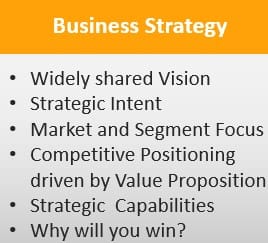Business Strategy
A sound strategy is hard to create, but invaluable when you want to increase profitable sales. Great strategy aligns your company on the critical tasks and capabilities that sales success demands. Grease believes in the power of strategy when companies get serious about making the changes and executing the initiatives the strategy requires. Getting serious starts with clarity, so Grease begins with a definition:
Strategy – a succinct and lucid statement of the idea a company pursues to attain its vision by creating and sustaining a competitive advantage.
-
- What is your vision?
- What is your strategic intent?
- What is your target market?
- How will you compete?
- What strategic capabilities will you require?

Grease Consulting works with you and your company to review your current strategy or help you craft a new one. You know your business; Grease knows strategy. Our goal is a sound strategy you and your colleagues believe in. We expect you to judge the success of that strategy by its ability to increase profitable sales, so we test to measure this performance early in the strategy’s rollout.
- Vision
Grease starts with your vision for the company because it paints a future picture for the enterprise that taps into employees’ aspirations. In Grease’s experience, if a business has a poorly drawn vision, or none at all, it usually fails to craft a successful strategy. Your vision need not describe changes and success ten or twenty years into the future. Often, looking out two or three years to describe medium-term success is more effective: employees grasp needs more quickly, the objectives you set are sharper, everyone feels greater urgency. Companies can link a series of medium-term descriptions of the future to increase long-term success and move the enterprise forward dramatically in a new direction.
- Strategic Intent
You chart that new direction by defining your strategic intent. You describe where the company is going in a compelling statement that employees can readily understand; a statement that challenges every employee to adapt, stretch, and meet new demands on the company. Grease works with you to distill and state your strategic intent because it provides long-term stability and continuity to a series of two-to-three-year transformations. Strategic Intent “captures employees’ imaginations and clarifies criteria for success” (Gary Hamel & C.K. Prahalad, “Strategic Intent,” Harvard Business Review, 1989, reprinted 2005). It’s a vital step in realizing the vision for the business.
- Why Will You Win?
How do you implement the strategy; what is required to make it operational? Strategies that never get implemented are worse than useless; they’re dispiriting and undermine initiative. To avoid this outcome, Grease advises clients to concentrate in three areas as they implement their strategies.
First, we ensure that a company has defined its value proposition and strategic capabilities rigorously because clarity and insight here will suggest many of the implementation tasks that the strategy requires. Second, we help clients assess their capabilities against the demands of the strategy. Implementation success requires a company’s employees to complete essential tasks accurately, on time, consistently, and with enthusiasm. Friction here will grind a strategy to irrelevance. Increase internal effectiveness by removing the friction and watch the strategy flourish.
Finally, we imbed the strategy in a business plan because without such a plan a strategy is merely a well-documented aspiration. Successful strategy requires a company to change: to undertake and successfully conclude specific initiatives, programs, and tasks. Well-run companies manage themselves with business plans, which they pursue with excellent project management discipline. This is how the important, non-routine “stuff” gets done.
Imbedding strategy in a business plan confers a second benefit: better strategy. Great strategy is grounded in your vision and the company’s strategic intent. Great strategy is iterative, adaptive, responsive to change, and forthright about what is not known or assumed. That iteration, adaptation, and response depend on new information, on accurate feedback from your business and the real world where it operates. The people implementing your business plan know that real world. Imbed strategic objectives in that plan and you create the feedback that sharpens your strategy and multiplies its impact.
From our clients:
I have known Harry for more than 15 years and have worked with him in a variety of business situations, ranging from software to building materials. He has superb educational credentials that reflect an extraordinary intellect, and that makes him effective against almost any business challenge. He listens carefully, assesses situations quickly and accurately, and then executes, always in tandem with his client. He lives and works by his values and his integrity is beyond reproach.
Roger L. Pringle
Founder, The Pringle Company
My experience working with Grease is that its principals are high-energy, engaging, skilled, persistent, and non-confrontational. The Grease team represents a broad swath of capabilities from strategy to sales, all grounded on an uncompromising bias for action to improve execution, increase speed, enhance competitive advantage and create value.
Dave Dullum
President, Gladstone Investment Corporation
